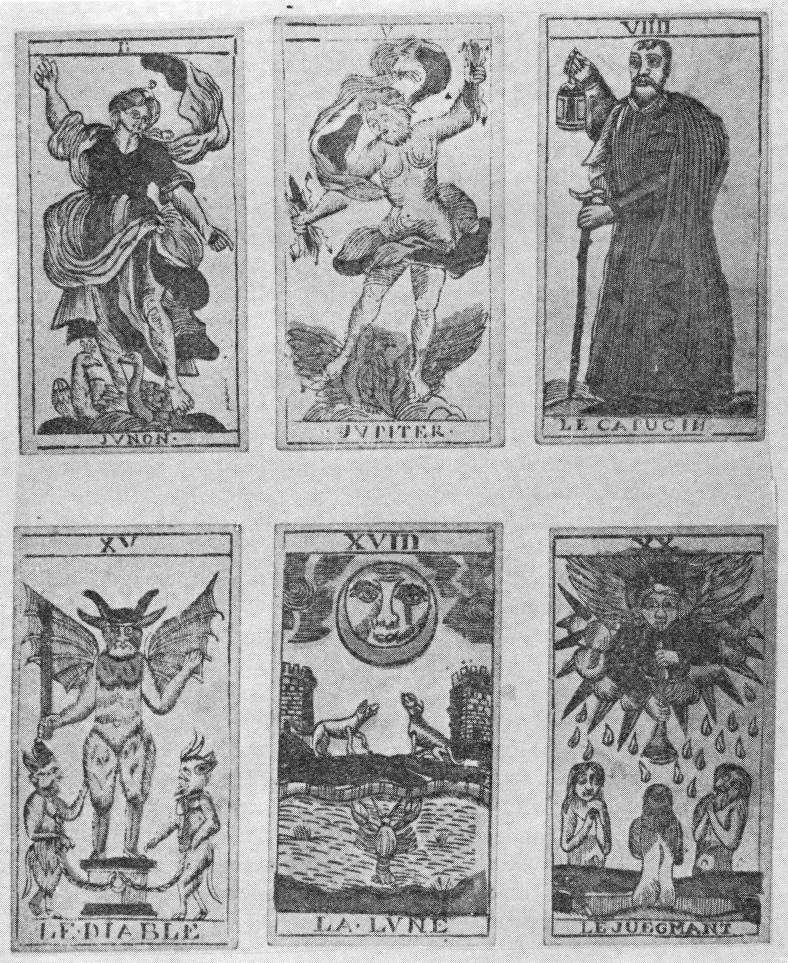

| Suit System: | IT |
| Recommended Name: | the Tarot de Besançon. |
This pattern was originally classified as IT-1.4.
Popularly known as the "Tarot de Besançon" which is the recommended
name although there is evidence that its origins lay further east.
The rejection of the figures of the Pope and Popess in certain Tarot trump series of several countries seems to have taken place around the beginning of the 18th century or, if Hargrave's dating is correct for Mayer of Constance, even earlier. The replacements generally chosen by the cardmakers of eastern France, Alsace, Germany and parts of Switzerland were Jupiter and Juno respectively, the most striking marks of identity of this pattern. However, while retaining the composition and general features of the Tarot de Marseille (IT-1) several other lesser details became established which also differentiate the Tarot de Besançon from that pattern (see below).
Early examples emanated from Constance (c.1680), Strasbourg (1746), Mannheim (1750) and it was not until about 1800 that any quantity of these cards were made in Besançon although d'Allemagne records that not only were Tarot cards made in the early 18th century but also that many were made for export, particularly Switzerland. The most interesting variants of this pattern lie in packs adapted during the Revolutionary period, the court cards and imperial figures losing their royal regalia: examples are known from Strasbourg and Colmar. Other minor variants were made in Switzerland and Germany.
The pattern can barely have survived the early part of the 19th century, being replaced in most areas by the French-suited Tarot packs, although a successor (IT-1.41) emerged in Diessenhofen in c.1860.
78 cards. 4 suits of 4 single-figure court and 10 pip cards, plus 21 numbered single-figure trumps and the Fool which, together with the court cards are captioned in French (often very corrupt). Distinguishing cards: Trump II = Junon; V = Jupiter; XV, the Devil has furry trousers and torso; XVIII, the Moon shows a full face; XX, rays and "tears" emanate from the cloud; the Fool is called "Le Fol"; the jack of Batons has both hands on top of the baton; the ace of Cups is a large, covered cup.
F. Laudier (1746), Anon (18th century), L. de Laboisse (revolutionary), L. Carey (revolutionary), all of Strasbourg;
Pelagius Mayer, Constance (c.1680);
Guillaume Mann, Colmar, (revolutionary);
Renault, J.Blanche, J.Jerger, A. Kirchner, all c.1800, Besançon.
Variants, apart from those caused directly by the Revolution:
a) Trump XV, the Devil has furry trousers but not furry torso, made by Neumur, Mannheim (c.1750);
b) Trump XVIII, face in Moon is in profile, made by Schaer, Mumlisweil (c.1780);
c) Trump XV, the Devil has loincloth, jack of Batons has one hand at top of baton, one lower down, made by Krebs, Freiburg (c.1780)
A HISTORY OF PLAYING CARDS... by C.P. Hargrave, Boston 1930.
LES CARTES A JOUER DU XIVe AU XXe SIECLE by Henry-René d'Allemagne, Paris, 1906.


| Eleven cards from a pack made in Besançon,
c.1800. Bottom row, far right, typical Revolutionary modification of Trump III next to its conventional equivalent. |
| The International Playing-Card Society | Undated |